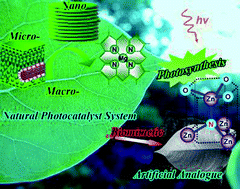A green leaf can be viewed as a solar collector and an energy converter crammed with photosynthetic cells, and could be termed a “natural photocatalyst system (natural-PCS)”. Here, we put forward a general biomimetic strategy of copying Mother Nature—an artificial photocatalyst system (artificial-PCS) produced by replacing the natural one in green leaves. The artificial N-doped ZnO photocatalyst system, as a typical prototype, is generated through a two step infiltration process by copying the elaborate architecture of green leaves from macro-, micro- to nanoscales and the N contained in original leaves is self-doped into the resulting samples. The absorbance intensities within the visible light range of artificial N-ZnO PCS derived from different leaves increase by 84%–131%, and the band gap absorption edges exhibit clear red shifts compared with the bulk counterparts, demonstrating the highly efficient light-harvesting capacity in the UV-visible light region. Moreover, the artificial N-ZnO PCS possesses superior photocatalytic activity especially in the visible light region proved by EPR study and by degradation of methylene blue under solar energy irradiation. Thus, the artificial biomimetic analogues realize the structure inheritance and function imitation of the natural-PCS. This work may establish a methodology for learning from nature and for utilization of solar energy with man-made analogues.

You have access to this article
 Please wait while we load your content...
Something went wrong. Try again?
Please wait while we load your content...
Something went wrong. Try again?


 Please wait while we load your content...
Please wait while we load your content...